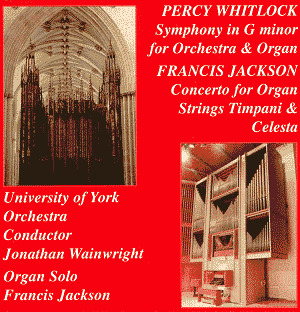PERCY WHITLOCK (1903-1946)
Symphony (organ and orchestra)
FRANCIS JACKSON (b.1917)
Organ Concerto
 Francis Jackson (organ)
Francis Jackson (organ)
University of YorkSO/Jonathan Wainwright
rec 20/21June 1999, York Minster
 AMPHION PHI CD 155
[74.30]
AMPHION PHI CD 155
[74.30]

Whitlock's only Symphony was premiered in Bournemouth on 21 March 1937. It
has the command and bearing of a 1930s symphony and is certainly more symphony
than organ concerto. Organ-phobes need not steer clear. In fact this work
is as essential to an appreciation of the British musical renaissance as
knowing the Vaughan Williams, Bax and Moeran symphonies.
The first movement of the Whitlock has the plunging romanticism of Louis
Glass's Fifth Symphony, Atterburg's Third, Madetoja's Second and
Peterson-Berger's Journey to the South. True the work shows Elgarian influences
(notably the second symphony) but it is these Nordic romantic voices that,
for me, delightfully dominate the allegro sostenuto. I cannot imagine
anyone who is into these late romantics being anything other than captivated.
The second movement (Elegy) has more than a few Finzian moments while the
scherzo skims and skips along in blowsy insouciance. The finale is at first
rendered rather four-square but rises to a statement of lyrical eminence
which we more readily associate with Rachmaninov before diving into a skittering
reflection of the flightier moments of the Elgar Second Symphony. The generously
expansive theme is floated high, grand and wide before a conventional ending
resonating in the long echo of York Minster.
The much more recent (1985) Jackson, while no pushover, is still a tonal
work. Its complexities can be related to the Poulenc Concerto. It has the
same somewhat French 'Gothick' harmonic scrunch mated to a tangy mélange
of Walton and Bax. A cloistered theme of austere and casual loveliness is
ushered in at 3.35 in I. This has a feel of Copland and Barber while the
second movement delectably continues this line - try the simply glorious
theme presented on violins at 2.48 in II. The allegro returns to the surging
melodrama of the first movement before developing a fine and dignified tune
recalling Vaughan Williams. The work was written for the Carnegie Trust in
1985 and was premiered in Carnegie's native Dunfermline.
Decent notes by the composer in one case and, for Whitlock, by Malcolm Riley
of the Whitlock Trust.
I hope that this signals a number of new issues from Amphion. Can we now
hope for Jackson's Symphony and Brigantia overture - both for orchestra?.
I certainly want to hear these works after experiencing the concerto. I also
hope that someone will go on to record the Mathias and Arnold concertos (the
latter a surefire winner) and the Peter Racine Fricker symphony No. 5.
The odd cough and rustle of page turning occasions no upset at all. Martin
Monkman has worked enchantment on a most inflexible and inimical recording
venue. My only 'complaint' is that greater weight should have been given
to the strings. Amphion deserve considerable success with this disc.
Rob Barnett

Enquiries about Whitlock and performance of this strong symphony of the 1930s
should be directed to the Percy Whitlock Trust at 32 Butcher Close, Staplehurst,
Kent TN12 0TJ.
The CD can be obtained in the UK via Priory Records or from any location
direct from Amphion Recordings, Norton Lodge, 109 Beverley Road,
Norton-on-Derwent, Malton, N.Yorks YO17 9PH. Phone/Fax 01653 698372. Sorry
no e-mail.
Cheque for £12.99 payable to Amphion. Concession prices for members
of the British Music Society.
